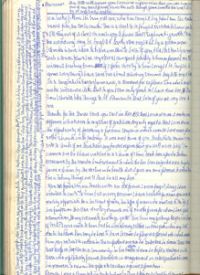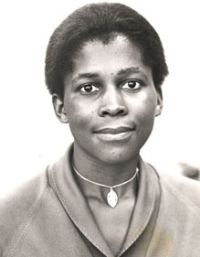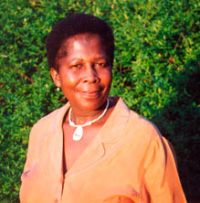July 22, 2008 – In May 2008, Ruth Muller, one of the Nelson Mandela Foundation archivists working with Mr Mandela’s personal papers, came across a letter, dated January 1971, in a book of “Family Correspondence” and addressed to “Nomvula”.
At the bottom of the hand-written letter (which would have been written out in the book before it was re-written on letter paper and sent – via the Robben Island authorities) was the name and address of the intended recipient:
Miss Joyce Sikakane
c/o Nkosikazi Nobandla Mandela
8115 Orlando West
Johannesburg
Realising that this was someone she knew, Muller emailed a transcript of the letter to Joyce Sikhakhane – now Mrs Joyce Sikhakhane-Rankin. This was her response, even before she had had a chance to read the letter: “I never ever received the Madiba letter. What a precious gem. You are such a darling to tell me about it. Am dying to read it no matter what its content ...”
Sikhakhane-Rankin was born in 1943 in Soweto. She was the first black woman to be employed as a journalist on the Rand Daily Mail. She was involved in underground activities in the 1960s which led to her arrest, with Winnie Mandela and 20 others. She was tortured during her 18-month long detention, charged in what came to be known as the “Trial of the 22” and acquitted.
After her release she continued ANC underground work before leaving the country in the early 1970s. She married Dr Ken Rankin and they lived in Zambia, Zimbabwe, Mozambique and Scotland before returning to South Africa in the early 1990s. Throughout her exile she continued to work for the ANC.
On her return she worked for the National Intelligence Agency and the SABC. She is the author of A Window on Soweto (London, IDAF, 1977), executive producer of the film A South African Love Story: Walter & Albertina Sisulu, and co-producer of Samora Machel: Son of Africa. She was one of the consulting editors for Elinor Sisulu’s book Walter & Albertina Sisulu: In Our Lifetime (Cape Town, David Philip, 2002).

Nelson Mandela's letter to "Nomvula"
(Image: Nelson Mandela Foundation)NMF: Before this letter was written from the island, had you ever met Nelson Mandela?
JSR: No. I lived with my parents at number 7703 Lembede Street [Orlando West]. The Mandela family lived at number 8115 Ngakane Street. The streets ran parallel to each other – Lembede being at the top and Ngakane below. At the time Orlando West was the second township built after Orlando East - Soweto [South Western Native Township] had not yet developed into the vast expanse it is today.
Therefore, during my early childhood I used to play with the Mandela children [Mr Mandela’s children by his first wife, Evelyn]. The Sisulu family lived a few streets above ours, near the Maketha grocery shop and the Holy Cross Primary School. I do not remember any introductions of us children to our respective parents. However, as children we knew that that’s so-and-so’s father or mother. Our parents were never around during daytime. They were at their various places of employment. We would invariably see them arriving home late in the afternoon when they returned home from work. We would also be running home, having been playing games in the streets.
Now, in 1954 Bantu Education was introduced. I was a pupil at the Holy Cross Primary School run by the Anglican Church. Father Trevor Huddleston was in charge. The ANC called a boycott. As a result our school closed.
Secondly, my parent’s marriage was breaking down. Two years later my father sent us children to Clermont township in Durban to live with my grandparents. I then attended a local primary school. At about the same time the Mandela family unit suffered a similar breakdown.
NMF: I understand that you were an activist from an early age: please tell me something about your family – especially your grandfather?
JSR: Yes. When we joined our grandfather, the Reverend Absolom Mbulawa Sikhakhane, [in Durban] we found him very active in the ANC. Branch meetings were held on his plot at Mvuzane in Clermont. He was also the Natal ANC Chaplain, working very closely with the ANC President, Chief Albert Luthuli. Whenever there were the ANC executive branch meetings we would join in the opening prayers and singing of “Mayibuye, mayibuye iAfrica, eyathathwa amabhunu, sifuna inkululeko.” Members would then say, “Africa, Mayibuye. Mayibuye, iAfrica.” The branch executive committee discussions were always within my earshot. I was also a member of the local [ANC] Pioneers. During the week Grandpa would send me as a messenger to his comrades. I would go to and fro delivering political correspondence and reading materials.
My grandfather was detained during the 1960s State of Emergency. I was at boarding school – at Inanda Seminary – when that happened. Edith Yengwa, the wife of MB Yengwa, a provincial ANC executive member, explained to us what the State of Emergency was all about. She not only instilled the spirit of resistance against apartheid in us, but was instrumental in providing cover for our underground political activities, such as attending the meetings of the African Students Association (ASA).
NMF: How did you become a reporter on the Rand Daily Mail and when?
JSR: I took a job at the RDM in 1968 after I had made an application. If I remember correctly it was Raymond Louw who placed me on a fulltime contract. The RDM had created what was called the “township newsroom”. It was at the latter newsroom that I, at separate times, worked under Benjamin Pogrund and Allister Sparks. The woman journalist I worked closely with was Jill Chisholm in the main newsroom. She later left South Africa to work for ITN in the UK.

Joyce Sikhakhane-Rankin in the 1970s.
(Image: Supplied)NMF: Who was “John” and how did you meet? Did you marry each other?
JSR: “John” was Samson Fadana, who had just been released from Robben Island. I was introduced to him by the then Winnie Mandela. We were at one of our secret meeting points. Winnie and I were both banned and restricted and Winnie was also under house arrest. On seeing me, John immediately professed to have fallen in love. Now, before serving banning and restriction orders, I had been in prison for almost two years. Earlier than those ordeals I had been engaged to Ken Rankin in 1968. He had to leave South Africa. I was supposed to follow. Alas, I became the captive of the South African Security Police. I believed I would never be able to leave South Africa. I therefore wrote a letter to Ken freeing him from the engagement obligation. So, when “John” proposed marriage I agreed. This happened two or three days after the secret meeting.
We walked to the Johannesburg Magistrate’s Court where along the corridors we at random picked two witnesses and thus got the marriage registered. A day after that a car load of Security Branch men arrived at home and told me that I would be charged for entering the Magistrate’s Court illegally and having been in the presence of more than one person. They told me that my so-called marriage was null and void because it was done illegally. That was the end of the marriage. It was never consummated.
NMF: Reading the letter, it is clear that there are “messages” in it for or about someone else – for instance on the first page where he refers to “a woman – I believe she lives in your street” and page two where he mentions “our sister”. Who was this and what was your relationship with this woman?
JSR: I believe the woman Madiba was referring to in both instances was his then wife Winnie. The Sikhakhane and Mandela homes were a street away from each other. I got to meet Winnie on return to Johannesburg from boarding school. She was the social worker assigned to deal with our custody (as children) during my parents’ divorce proceedings. She did a sterling job because my mother won custody.
NMF: Can you identify any of the other people mentioned in the letter?
JSR: Yes, I can identify the following people. Thoko: her surname is Mngoma. She was an ANC activist in Alexandra township. She was also detained and stood [trial in the] Trial of the 22. Rita: her surname is Ndzanga. She was an ANC activist and trade unionist. She was also one of the accused in the Trial of the 22. Her husband Lawrence was murdered in detention by the security police. Her two sons were in the MK but died after 1994. Benjy, I should think, was Benjamin Pogrund.
NMF: Right at the end, Madiba says, “I have seen a couple of your manuscripts … I was highly impressed …” What was he referring to there, do you think?
JSR: Judging from the period of the letter, Madiba may have been referring to newspaper articles published under my by-line. I cannot think of anything else.
NMF: Lastly, how did you feel on receiving this letter 37 years after it was sent?
JSR: I feel privileged and overwhelmed. At the same time I thank God that through a human act I got Madiba’s mind to break from the desolate silence of Robben Island and write such a beautiful, romantic letter. He is an extraordinary soul.

Note concerning Samson “John” Fadana. Fadana was from Zola in Soweto. He was arrested around 1963 in Livingstone, in then-Northern Rhodesia, with a group of other MK cadres charged with leaving the country illegally and receiving military training and sentenced to a term on Robben Island. He arrived on the Island in June 1965 and left in June 1971. Not very long after his release he was banished to the Eastern Cape. After 1994 he became a member of the Eastern Cape Provincial Legislature and died in 1999 at his home in Engcobo. It’s also interesting to note that a Chief Fadana was sent to Robben Island in the 1850s not long after the so-called “cattle killings”. He died on the island.
Download a transcript of the letter in pdf format, by clicking here.